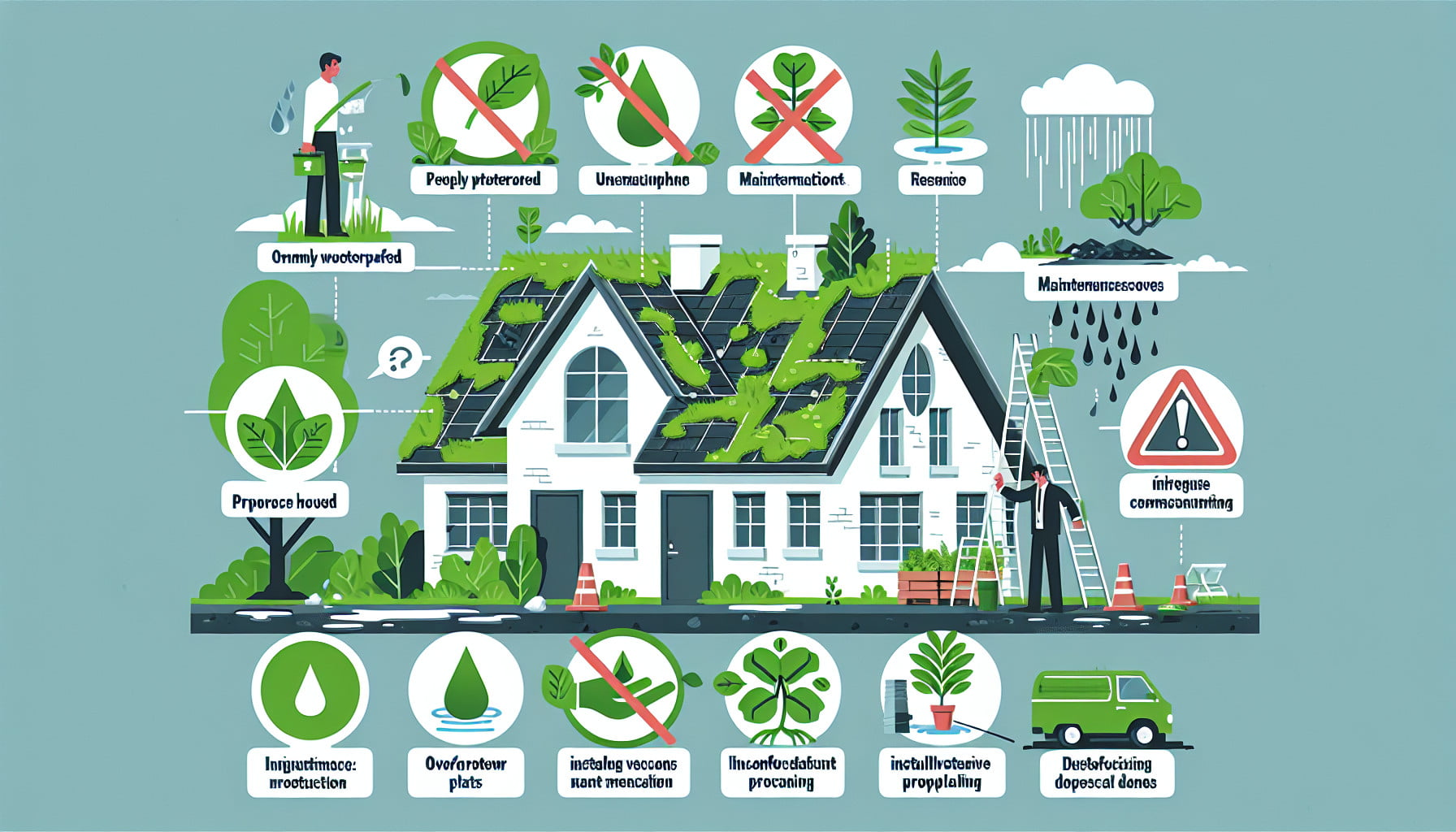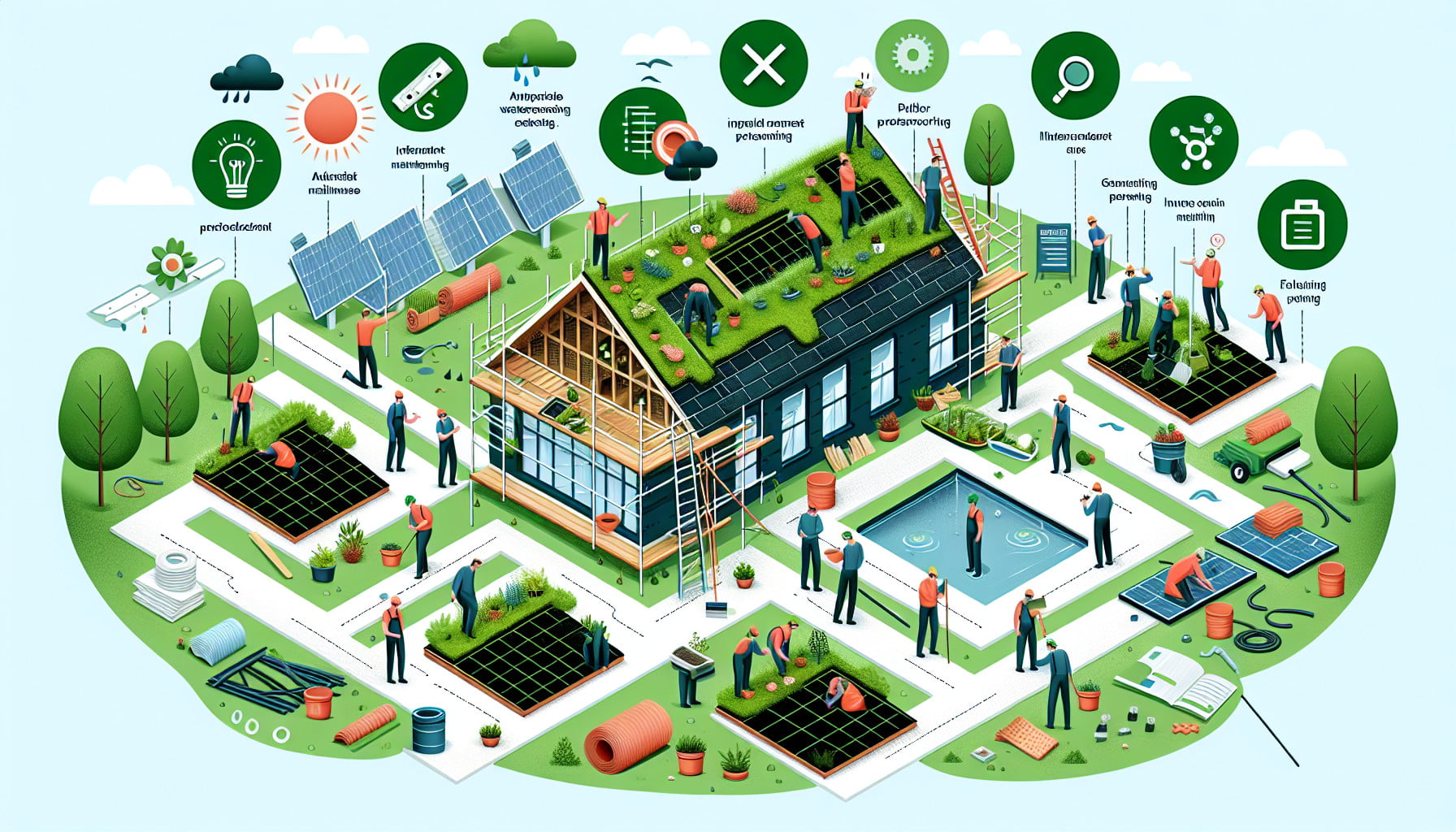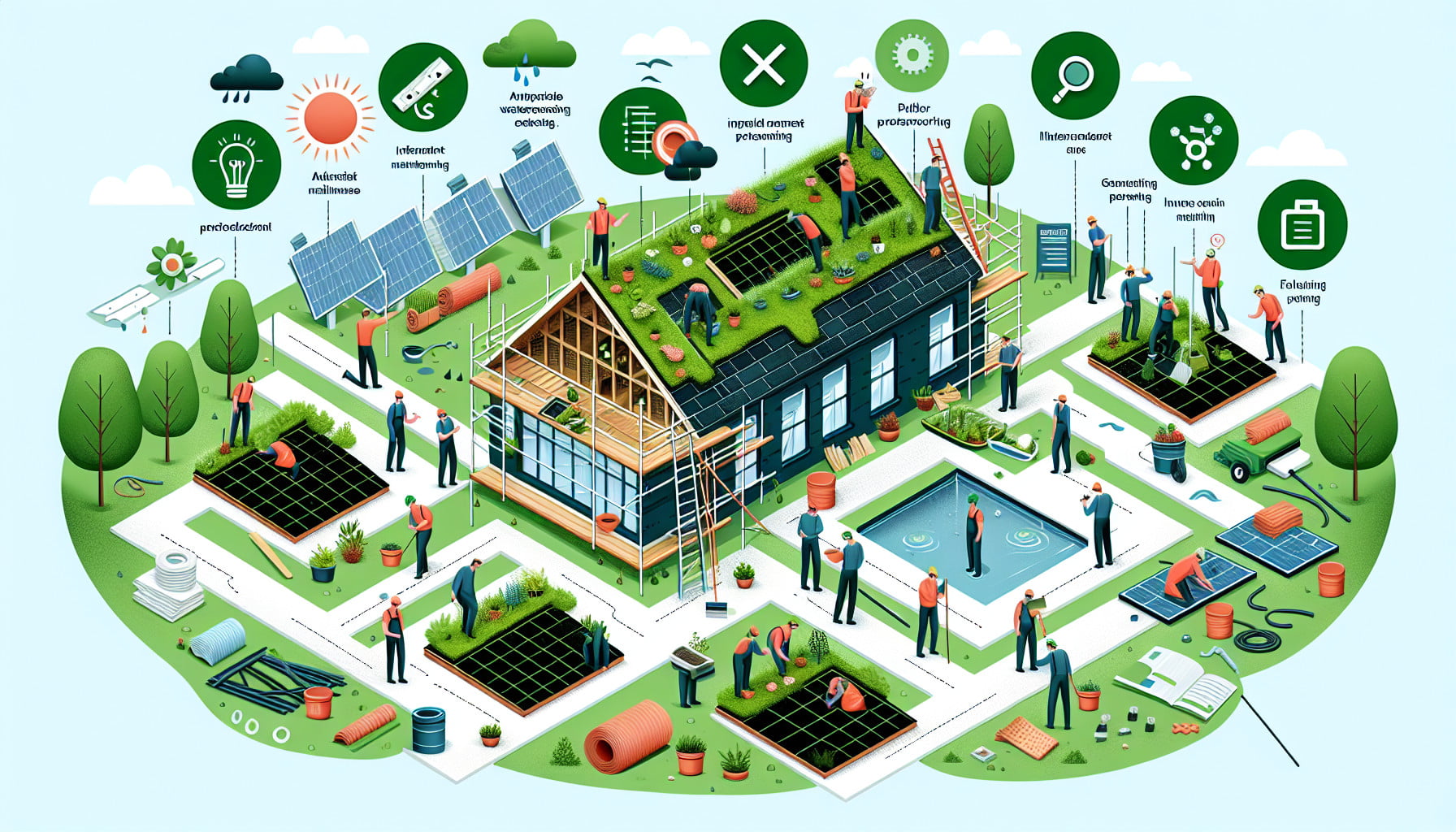So you’ve decided to embark on the exciting project of installing a green roof. Adding an eco-friendly touch to your building not only enhances its aesthetic appeal but also promotes sustainability. However, there are a few common mistakes that many people make when they undertake this endeavor. In this article, we will explore some of these mistakes and provide you with valuable tips on how to avoid them. By steering clear of these errors, you can ensure a successful and thriving green roof that will bring you joy and environmental benefits for years to come.

Choosing the Wrong Plants
When it comes to installing a green roof, one of the most crucial factors to consider is selecting the right plants for your climate. Picking plants that are not suitable for the local climate can result in poor performance and even plant mortality. Each region has its own unique climate, including temperature ranges, precipitation patterns, and sunlight exposure. It’s essential to choose plants that can tolerate the specific conditions of your area to ensure their success on your green roof.
Another mistake to avoid is selecting invasive plant species. Invasive plants can quickly overtake other plants and disrupt the ecosystem of your green roof. They compete for resources, crowd out native plants, and can spread to surrounding areas outside of your green roof. Make sure to research and choose plants that are native or non-invasive to ensure the long-term health and stability of your green roof.
Additionally, neglecting to consider the weight and maintenance requirements of the plants can lead to significant problems down the line. Green roofs require regular maintenance, including pruning, fertilizing, and watering. It’s essential to choose plants that are suitable for the available maintenance resources and can thrive in the specific weight and load-bearing capacity of your roof.
Insufficient Structural Support
Without adequate structural support, your green roof could pose a significant risk to the integrity and safety of your building. Failing to assess the load-bearing capacity of the roof can lead to structural damage, leaks, and potentially even collapse. Before installing a green roof, it is crucial to consult with a structural engineer to evaluate the structural requirements and reinforce the roof if necessary. This step is essential for ensuring the long-term stability and safety of your green roof.
Ignoring structural reinforcement needs is another mistake to avoid. Green roofs can add significant weight to a building, and if the existing structure is not reinforced to accommodate the additional load, it can lead to structural failure. Working with a structural engineer will help determine the reinforcement needs and implement the appropriate measures to support the weight of the green roof.
Improper Waterproofing
Proper waterproofing is essential to prevent leaks and water damage to the underlying structure of your building. Using inadequate or low-quality waterproofing materials can result in water seepage, which can lead to rot, mold, and damage to the interior of your building. It’s crucial to invest in high-quality waterproofing materials that are suitable for green roofs and have a proven track record of durability and effectiveness.
In addition to using the right waterproofing materials, neglecting to install a protective root barrier can cause problems. Without a root barrier, plant roots can penetrate the waterproofing membrane, compromising its integrity and leading to leaks. Make sure to install a root barrier to prevent any potential damage from plant roots.
Furthermore, the installation of the waterproofing layer must be executed meticulously to ensure its effectiveness. Poorly executed installation can lead to gaps, overlaps, or improper sealing, which can compromise the waterproofing system. It’s essential to hire experienced professionals who are skilled in waterproofing installations to guarantee the highest level of protection for your green roof.
Inadequate Drainage
Proper drainage is crucial for the health and longevity of a green roof. Without sufficient drainage outlets, excess water can accumulate and lead to waterlogged soil and root rot. It’s essential to design and install an adequate drainage system that allows water to flow off the roof efficiently.
Using improper or clogged drainage materials is another mistake to avoid. The drainage materials should be appropriate for green roofs, allowing proper water movement and preventing blockages. Regular maintenance and inspections should be performed to clear any potential clogs and ensure the drainage system is functioning optimally.
Additionally, failing to slope the roof for proper water runoff can lead to pooling water and inadequate drainage. The roof should be sloped to allow water to flow towards the designated drainage outlets. This slope needs to be carefully planned during the construction phase to ensure effective water management on the green roof.

Incorrect Irrigation System
An irrigation system that does not meet the specific needs of your green roof can lead to plant stress, poor growth, and even plant death. It’s essential to choose an irrigation system that provides the right amount of water at the appropriate times. Factors such as plant species, climate, and rainfall patterns should be considered when designing the irrigation system.
In addition to proper irrigation, it’s essential to install a rainwater harvesting system. Rainwater harvesting can supplement watering needs, reduce reliance on potable water sources, and improve sustainability. By collecting and storing rainwater, you can ensure a more efficient and environmentally friendly approach to watering your green roof.
The placement of irrigation lines is also crucial to avoid potential issues. Improper placement can result in uneven watering, missed areas, or damage to the system during maintenance activities. It’s important to work with experienced professionals who understand the intricacies of irrigation system design and implementation.
Lack of Professional Guidance
Installing a green roof is a complex undertaking, and ignoring professional guidance can lead to costly mistakes. Not seeking advice from experienced green roof professionals can result in design errors, plant selection issues, and inadequate system installation. Professional guidance ensures proper planning and execution of your green roof, considering all necessary variables.
Disregarding local building codes and regulations is another common mistake. Each jurisdiction may have specific requirements and restrictions when it comes to green roof installations. Failing to adhere to these regulations can lead to fines, legal issues, and the potential removal of the green roof. It’s crucial to consult with local authorities and ensure compliance with all applicable codes and regulations.
Consulting with a landscape architect is highly recommended when planning a green roof. They possess the expertise to design functional and aesthetically pleasing green spaces that integrate seamlessly with the surrounding environment. Landscape architects can help optimize the design of your green roof, create habitat opportunities for wildlife, and ensure the overall success of your project.
Ignoring Roof Maintenance
Regular inspections and maintenance are essential for the longevity and performance of your green roof. Neglecting these tasks can lead to the accumulation of debris, clogged drains, and plant health issues. It’s important to incorporate access points for maintenance purposes, allowing easy and safe access for inspections, cleaning, and repairs.
Weed control is another critical aspect of roof maintenance. Neglecting the need for weed control can result in invasive plants taking over the green roof and compromising the health of the desired plant species. Regular weeding and the implementation of appropriate weed control measures are essential to preserve the intended design and functionality of your green roof.
Failure to Consider Sun Exposure
Installing a green roof without analyzing the sunlight exposure can lead to plant stress and poor growth. Different plants have varying sunlight requirements, and it’s important to choose species that are suitable for the available sunlight on your roof. Some plants thrive in full sun, while others prefer partial shade. By understanding the sunlight exposure, you can select plants that will flourish in your specific conditions.
Not providing sufficient shade for heat-sensitive plants is another mistake to avoid. Exposure to prolonged and intense sunlight can cause heat stress and damage to certain plant species. It’s important to incorporate elements such as shade structures or strategically place taller plants to provide shade for those more sensitive species.
Underestimating the impact of reflected heat is another aspect that should not be overlooked. Surrounding buildings or surfaces can reflect sunlight and significantly increase the temperature on your green roof. Careful consideration should be given to the positioning of reflective surfaces and their potential effects on the plants’ well-being.
Ignoring Wind Effects
Failing to consider the potential wind effects on your green roof can result in plant damage, soil erosion, and a compromised growing environment. Wind can cause excessive drying of the plants and soil, hinder growth, and even uproot plants if strong enough. It’s crucial to assess the wind patterns in your area and choose wind-resistant plant species.
Not selecting wind-resistant plants is another mistake to avoid. Some plant species are better adapted to withstand strong winds and turbulent conditions. By choosing wind-resistant plants, you can ensure the longevity and health of your green roof, even during periods of high wind.
Implementing windbreaks or wind barriers can help reduce the potential impact of strong winds on your green roof. Windbreaks can be created using features such as walls, hedges, or plantings to provide a buffer and protect the more vulnerable areas of your green roof.
Inadequate Soil Depth
The depth of the soil layer on your green roof plays a critical role in plant health and water retention. Using shallow soil that restricts plant root growth can limit the ability of plants to access necessary nutrients and water. It’s important to provide sufficient soil depth to allow for proper root development and ensure the long-term success of your green roof.
Not providing enough soil depth for proper water retention can lead to inadequate water availability for the plants. The soil should have the capacity to retain water and release it slowly to support plant growth and prevent water runoff. By considering the specific water needs of your chosen plant species, you can determine the appropriate soil depth required.
Incorporating layers for adequate root development is another vital aspect of green roof construction. The layers should include provisions for proper root growth and nutrient availability, such as drainage layers, filter fabrics, and growing media. Neglecting to incorporate these layers can inhibit plant growth and compromise the overall health of your green roof.
In conclusion, installing a green roof can be a complex process, but by avoiding these common mistakes, you can ensure the success and longevity of your project. From the selection of suitable plants and proper structural support to adequate drainage and soil depth, every aspect must be carefully considered and executed. Seeking professional guidance, adhering to local regulations, and providing ongoing maintenance will help you create a beautiful, functional, and sustainable green roof that benefits both your building and the environment.

